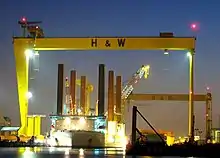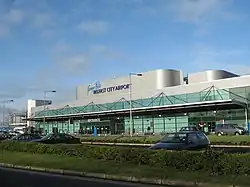Economy of Northern Ireland
The economy of Northern Ireland is the smallest of the four constituents of the United Kingdom and the smaller of the two jurisdictions on the island of Ireland. At the time of the Partition of Ireland in 1922, and for a period afterwards, Northern Ireland had a predominantly industrial economy, most notably in shipbuilding, rope manufacture and textiles, but most heavy industry has since been replaced by services.[8][9][10][11][12][13][14] Northern Ireland's economy has strong links to the economies of the Republic of Ireland and Great Britain.
 Belfast City Centre | |
| Currency | Pound sterling (£) |
|---|---|
Trade organisations | WTO, OECD |
| Statistics | |
| GDP | £48.374 billion (nominal; 2021) [1] |
GDP growth | |
GDP per capita | £24,900 (nominal) / £23,200 (PPP) |
Millionaires (US$) | 14,000 (£)[3] |
Labour force | 897,000 (Jan 2016)[4] |
| Unemployment | 5.7% (Jan 2016) |
Average gross salary | £2,295 / €2,665 / $3,132 (monthly) |
Main industries | Services, construction, agriculture, public sector |
| External | |
| Exports | £19.03 billion (2018)[6] |
Export goods | List
|
Main export partners | |
| Imports | £21.5 billion (2018)[7] |
Import goods | List
|
Main import partners | |
Overview
Output and economic growth
Northern Ireland has the smallest economy of any of the twelve ITL 1 regions of the United Kingdom, at £27.4bn (€37.8bn). However, this is partly because Northern Ireland has the smallest population; at £15,200 (€21,000) Northern Ireland has a greater GDP per capita than both North East England and Wales.
Rural areas including the North West are particularly deprived. It suffers from the highest unemployment and highest poverty rates in Northern Ireland.
Throughout the 1990s, the Northern Irish economy grew faster than the rest of the UK, due in part to the rapid growth of the economy of the Republic of Ireland and the so-called "peace dividend". An April 2007 survey found Northern Ireland's average house price to be one of the highest in the UK, behind London, the South East, and the South West. It also found Northern Ireland to have all of the top ten property "hot spots", with the Craigavon and Newtownards areas increasing by 55%.[15] However, as of 2018 Northern Ireland house prices are the lowest on average in the UK, approximately 40% lower than before the bubble burst in 2008.
Employment
Unemployment in Northern Ireland has fallen substantially in recent years, and is now roughly at 6.1%, down from a peak of 17.2% in 1986.[16][17] Youth unemployment and long-term unemployment have fallen most quickly. Working-age economic inactivity is 28%, which is the highest of any UK region.[18]
Northern Ireland's macroeconomy is also characterised by considerably longer actual working hours and lower gender income disparity than in the United Kingdom as a whole.[18]
Investment
Foreign direct investment was restrained by The Troubles. Since the signing of the Good Friday Agreement, investment in Northern Ireland has increased significantly. Most investment has been focused in Greater Belfast and to a lesser extent Greater Derry. Major projects include the Victoria Square Shopping Centre Belfast City Centre. Titanic Quarter is a waterfront development under construction.[19] The Laganside Corporation was previously at the forefront of the redevelopment along the banks of the River Lagan. The Cathedral Quarter has also seen substantial investment. In Derry, the ILEX Urban Regeneration Company no longer exists. The area is 12th in terms of funding despite it being the second city.
Agriculture
Agriculture in Northern Ireland is heavily mechanised. In 2000, agriculture accounted for 2.4% of economic output in Northern Ireland, compared to 1% in the United Kingdom as a whole.[20] As in the rest of the United Kingdom, livestock and dairy account for the majority of agricultural output. The main crops are potatoes, barley, and wheat.
Manufacturing

Machinery and equipment manufacturing, food processing, textile and electronics manufacturing are the leading industries. Other industries such as papermaking, furniture manufacturing, aerospace and shipbuilding are also important, concentrated mostly in the eastern parts of Northern Ireland.
Northern Ireland experienced a period of steep manufacturing growth between 1998 and 2001.[21]
Engineering is the largest manufacturing sub-sector in Northern Ireland, particularly in the fields of aerospace and heavy machinery. Major employers are Moy Park, Spirit Aerosystems, Caterpillar and Seagate.[22]
Harland and Wolff, which in the early 20th century was the world's biggest shipbuilder, suffered from intense international competition during the 1970s and 1980s and declined rapidly. During the 1990s the company diversified into civil engineering and industrial fabrication, manufacturing bridges and oil platforms. The vast works on Queen's Island were downsized, with much of the land (including the slipway where RMS Titanic was built) sold off for redevelopment in the 2000s as the Titanic Quarter. H&W has not built a ship since 2003, but has seen workload increase through shipbreaking, ship repair and maintenance and conversion work. The company has also been active in the design and construction of offshore power generation equipment- both wind turbines and wave-action turbines.
Services
Services account for almost 70% of economic output, and 78% of employees.
Effects of the COVID-19 pandemic
The economy of Northern Ireland was negatively impacted by the lockdowns and travel restrictions necessitated by the COVID-19 pandemic. The tourism and hospitality industry was particularly hard hit. These sectors "have been mandated to close since 26 December 2020, with a very limited number of exceptions" and many restrictions were continuing into April 2021.[23] Hotels and other accommodations, for example, "closed apart from only for work-related stays".[24] Restaurants and pubs were restricted to take-away service. In February, the government said it would not consider "reopening hospitality before mid-summer".[25]
In late March, owners and operators of many types of businesses signed a petition "calling for the economy to reopen" and requested a "proper timetable plan" for rebuilding the economy. The content also discussed the "catastrophe" that the lockdowns and restrictions had created.[26] Government assistance was available; the £25,000 Retail, Hospitality, Tourism and Leisure Grant was closed by 25 March 2021 but "a further payment" was to be made to eligible businesses.
Some restrictions were expected to be loosened in mid April but tourism was expected to remain very limited.[27] Anyone entering NI and planning to stay for a day or longer was required to "self-isolate for 10 days"; this did not apply to those on "essential" trips. Everyone entering NI was required to provide evidence of a negative Covid-19 test.[28]
Public sector
As of December 2008 the public sector in Northern Ireland accounted for 30.8% of the total workforce; this is significantly higher than the overall UK figure. Overall, the figure for Northern Ireland has fallen. In 1992 the public sector accounted for 37% of the workforce.
In total in 2006, the British government subvention totalled £5,000m, or 20% of Northern Ireland's economic output.[29] This had risen to £11,547m in 2009–10 during the "Great Recession", and then fell back to £9,160m in 2013–14.[30] A 2017 article by a research professor at the Economic and Social Research Institute quantified the transfers at 10.8 billion Euro annually.[31] In late 2018 The Irish Times estimated that the subvention had risen to £10.8 billion, about a quarter of Northern Ireland's GDP.[32]
Currency
The official currency in use in Northern Ireland is the British pound sterling. The euro, in use in the Republic of Ireland, is also accepted by some retailers.
Four Northern Irish banks print their own sterling-denominated banknotes: Bank of Ireland, First Trust Bank, Northern Bank, and Ulster Bank. The central bank of the UK is the Bank of England.
Energy
Energy policy in the province is set by the Department for the Economy.
| Primary energy consumption (yearly)[33] | ||
|---|---|---|
| Source | GWh | % |
| Coal | 1,169.1 | 14.4 |
| Oil | 24.3 | 0.3 |
| Gas | 4,178.1 | 51.5 |
| Wind | 2,439.8 | 30.0 |
| Solar | 162.7 | 2.0 |
| Hydro | 15.2 | 0.2 |
| Other renewable | 364.1 | 4.5 |
| Net Imports | -236.8 | -2.9 |
| Total | 8,119.5 | 100 |
Electricity
Northern Ireland's electrical grid is operated by System Operator for Northern Ireland (SONI) and the distribution is managed by Northern Ireland Electricity (NIE) which owns and manages the infrastructure which connects over 850,000 customers. Electricity consumption in Northern Ireland was 7,867 GW·h in 2002/3.[34] At 4.6 MW·h per person, this is 18% less than that of the rest of the United Kingdom (5.6 MW·h per person). There are three main power stations in Northern Ireland: Ballylumford & Kilroot power stations located in County Antrim and Coolkeeragh power station in County Londonderry. The electricity grid throughout the island of Ireland is operated as a single system, with separate control centers in Dublin and Belfast.
Northern Ireland's electrical grid is connected to that of the Republic of Ireland by three cross-border interconnectors. The main interconnector, between Tandragee and Louth has a capacity of 1,200 MW. Two back-up interconnectors have a combined capacity of 240 MW. This combined all-island grid is connected to the National Grid on Great Britain by the 500 MW Moyle interconnector, under the North Channel.[35]
Gas
Gas for the Greater Belfast area is supplied via the Scotland-Northern Ireland pipeline (SNIP), a 24-inch-diameter (610 mm) interconnector. SSE Airtricity and firmus energy supply gas to the Greater Belfast area via Phoenix Natural Gas' network.
In the other areas of Northern Ireland, specifically towards Derry City, gas comes from two interconnector pipelines, one being supplied by the Republic's gas supplier, Bord Gáis. The North-West pipeline from Carrickfergus in County Antrim to Derry opened in November 2004, and the south–north pipeline from Gormanston (in the Republic) to Antrim was opened in October 2006. The complete south–north pipeline to Dublin opened in November 2007, passing Armagh, Banbridge, Craigavon and Newry. Since December 2005, Bord Gáis has supplied gas to residential customers in this area under the name firmus energy.
Transport

Northern Ireland has a total of 24,820 km (15,420 mi) of roads, or 1 km for each 68 people (1 mi for each 109 people), which is considerably more than in the United Kingdom as a whole (1 km per 162 people).[36] There are seven motorways in Northern Ireland, extending radially from Belfast, and connecting that city to Antrim, Dungannon, Lisburn, Newtownabbey, and Portadown.
Northern Ireland Railways (NIR) runs passenger trains and presently carries no freight. NIR connects Belfast Great Victoria Street and Lanyon Place to Antrim, Ballymena, Coleraine, Portrush, Derry along the Northern Corridor and the Belfast Suburban Rail network serves places near Belfast, along with the Enterprise (train service) connecting Lisburn, Portadown, Newry and across the border along the Dublin-Belfast railway line to Dublin Connolly.
Northern Ireland has three civilian airports: Belfast City, Belfast International, and City of Derry. Only Belfast City Airport is served by train, from Sydenham station on the Bangor Line.
Major seaports in Northern Ireland include the Port of Belfast, the Derry Port and the Port of Larne. The Port of Belfast is one of the chief ports of the United Kingdom, handling 17 million tonnes (16.7 million long tons) of goods in 2005[37]
In addition to these existing links, several organisations have proposed a tunnel under the North Channel, with one possible site connecting the eastern part of Northern Ireland to Wigtownshire. The idea has been given technical consideration since the 19th century.
Data
The Northern Ireland Statistics and Research Agency (NISRA) is the principal source of official statistics on Northern Ireland. These statistics and research inform public policy and associated debate in the wider society. NISRA is an Agency of the Department of Finance and Personnel.[38]
Alongside official national statistics a number of respected private sector surveys are used to understand how the economy is performing. These include the British Chambers of Commerce Quarterly Economic Survey[39] which has information on the performance of Northern Irish businesses since 1989.
Regional Disparity / North-South Divide
According to Eurostat figures, there are huge regional disparities in the UK with GDP per capita ranging from £11,000 (€15,000) in West Wales to £130,450 (€179,800) in Inner-London West. There are 26 areas in the UK where the GDP per person is under £14,500 (€20,000).[40]
1.1 million (60% of Northern Irish) live in these deprived districts; three of these are in Northern Ireland: Outer Belfast, North of Northern Ireland, West & South of Northern Ireland.
See also
References
- "GDP Northern Ireland 2019 | Statista Regional GDP". Statista. Retrieved 12 December 2018.
- "NI economy shrinks in first quarter of 2018". BBC News. Retrieved 14 April 2016.
- "Northern Ireland prosperity map". Barclays. Retrieved 14 April 2016.
- "NI Composite Economic Index Statistics" (PDF). Department of Enterprise, Trade and Investment. Retrieved 12 April 2016.
- "Ease of Doing Business in United Kingdom". Doingbusiness.org. Retrieved 24 January 2017.
- "Trade increases between Irish Republic and Northern Ireland, figures show, as firms avoid GB checks". www.economy-ni.gov.uk. 28 July 2021.
- "UK Regional Trade Statistics" (PDF). GOV UK.
- "Trade increases between Irish Republic and Northern Ireland, figures show, as firms avoid GB checks". export.org.uk. Retrieved 12 December 2021.
- "Northern Ireland Broad Economy Sales and Exports Statistics: Purchases and Imports Results 2018" (PDF). nisra.gov.uk. Retrieved 12 December 2021.
- "Broad Economy Sales and Exports Statistics". nisra.gov.uk. Retrieved 12 December 2021.
- "Gross domestic product of Northern Ireland from 1998 to 2019". statista.com. Retrieved 12 December 2021.
- "Statistics on UK trade with Ireland" (PDF). parliament.uk. Retrieved 12 December 2021.
- "Northern Ireland trade in goods, 2018" (PDF). Northern Ireland Assembly. Retrieved 12 December 2021.
- "Trade increases between Irish Republic and Northern Ireland, figures show, as firms avoid GB checks". www.economy-ni.gov.uk. 28 July 2021. Retrieved 12 December 2021.
- "NI dominates housing hotspot list". BBC News. 24 April 2007.
- "Statistical Press Release - Latest Labour Market Figures".
- "Northern Ireland's economic fears". Ryan, Orla; BBC, 22 June 2001. Retrieved on 17 June 2006.
- Economic Overview. Northern Ireland DETI. 2006. Retrieved on 17 June 2006.
- "Titanic Quarter". www.titanic-quarter.com.
- Portrait of the Regions: Northern Ireland. Eurostat. 2005. Retrieved on 17 June 2006.
- Quarterly Economic Review. Northern Ireland DETI. October 2005. Retrieved on 17 June 2006.
- "Northern Ireland's 50 biggest employers". BelfastTelegraph.co.uk. Retrieved 6 February 2023.
- "Summary of Restrictions for Tourism & Hospitality Businesses". Tourism NI. Retrieved 12 April 2021.
- "Coronavirus lockdown rules in each part of the UK". Institute for Government. Retrieved 12 April 2021.
- "Ireland pubs: The four things that need to happen for bars and restaurants to reopen". Irish Mirror. 8 April 2021. Retrieved 12 April 2021.
- "Covid-19: NI business leaders call for economy to reopen". BBC News. 31 March 2021. Retrieved 12 April 2021.
- Cooke, Emma (2 March 2021). "Can I visit Northern Ireland? Latest travel advice for holidays this summer; Northern Ireland's next easing of restrictions will happen on April 12, but don't expect too many changes". The Telegraph. Retrieved 12 April 2021.
- "NI Covid-19 restrictions: Your questions answered". BBC News. 11 September 2020. Retrieved 12 April 2021.
- Ruddock, Alan (8 January 2006). "Comment: Addicted to state subvention, north will suffer when it's gone". The Times. Archived from the original on 29 June 2011.
- "How dependent is Stormont on Westminster subvention?". FactCheckNI. 24 May 2016.
- Morgenroth, Edgar (15 March 2017). "A united Ireland would be worse off than the Republic". The Irish Times. Retrieved 23 November 2018.
- Gillespie, Paul (8 December 2018). "Post-Brexit Britain may not want to pay for Northern Ireland". The Irish Times.
- "System and Renewable Data Summary Report". EirGrid. Retrieved 25 May 2022.
- Energy. Northern Ireland DETI. 23 October 2003. Retrieved on 17 June 2006.
- Disposal of Moyle Interconnector. Viridian Group. 11 April 2003. Retrieved on 17 June 2006.
- Why Northern Ireland - Infrastructure Archived 15 March 2006 at the Wayback Machine. InvestNI. 2004. Retrieved on 17 June 2006.
- "2005 Trade Figures Released" Archived 3 May 2006 at the Wayback Machine. Port of Belfast. 13 February 2006. Retrieved on 17 June 2006.
- The Northern Ireland Statistics and Research Agency. NISRA. 2014. Retrieved on 16 June 2014.
- British Chambers of Commerce Quarterly Economic Survey Archived 7 June 2014 at the Wayback Machine. BCC. 2014. Retrieved on 16 June 2014.
- "Eurostat - Data Explorer". Archived from the original on 6 October 2014. Retrieved 19 October 2011.
External links
 Media related to Economy of Northern Ireland at Wikimedia Commons
Media related to Economy of Northern Ireland at Wikimedia Commons- Northern Ireland Executive departments responsible for economic policy:
